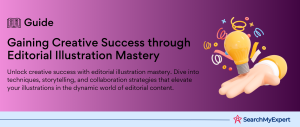The Business Side of Illustration: Unveiling the Art of Success
Picture this: an artist, brush in hand, creating not just captivating images but weaving a tale of entrepreneurial success. This isn’t just a story of artistic talent; it’s a narrative of business acumen, strategic thinking, and commercial savvy. Welcome to the fascinating world of illustration, where creativity meets commerce, and artistry aligns with entrepreneurship.
The Unseen Journey of an Illustrator
Behind every breathtaking illustration lies an untold story of business strategy. It’s a world where artists don’t just create; they negotiate, plan, and market. This journey is not just about mastering the stroke of a brush but also about understanding the dynamics of client acquisition, navigating the complexities of pricing, and staying afloat amidst legal intricacies.
Client Acquisition: The Art of Building Relationships
Acquiring clients in the illustration industry is akin to curating an art gallery. It’s about showcasing your unique style while appealing to the tastes and needs of potential clients. From leveraging social media platforms to attending art fairs, illustrators must employ a mix of traditional and digital strategies to attract and retain a diverse client base.
Pricing Strategies: Valuing Art and Skill
Determining the right price for your work is both an art and a science. It involves a delicate balance between valuing your skill and understanding market dynamics. Factors like the complexity of the project, time investment, and usage rights play a crucial role in shaping pricing strategies. Aspiring illustrators must learn to navigate this intricate aspect to ensure their financial sustainability.
Legal Considerations: Safeguarding Your Art
The realm of illustration is fraught with legal challenges, from copyright issues to contract negotiations. Understanding the legalities surrounding your work is crucial. This includes knowing how to draft a contract that protects your rights, understanding copyright laws, and ensuring that your intellectual property is respected and safeguarded.
Building Your Brand as an Illustrator: Crafting a Unique Identity
In the world of illustration, your brand is not just your business card; it’s your visual signature, your professional identity. Developing a strong, distinctive brand is essential for standing out in a crowded market and attracting the right clients.
Developing Your Visual Identity
- Crafting a Distinct Style:
Your illustration style is your voice in the art world. It should reflect your personality, interests, and unique perspective. This distinctive style becomes a magnet, drawing clients who resonate with your work. Whether it’s whimsical, realistic, abstract, or something entirely new, ensure it’s authentic and consistent across all your work. - Portfolio Development:
Your portfolio is the window into your artistic soul. It should be a carefully curated collection, showcasing not only your best work but also the diversity of your skills and styles. Ensure it’s accessible, easy to navigate, and highlights your range while maintaining your unique style. - Website Creation:
In today’s digital age, a professional website is a must. It’s the hub of your online presence, where clients can explore your portfolio, learn about your services, and contact you. Ensure it’s visually appealing, reflects your brand identity, and is optimized for search engines. - Social Media Presence: Social media platforms like Instagram, Pinterest, and LinkedIn are powerful tools for illustrators. They offer a stage to showcase your work, share your creative process, and connect with a global audience. Regular posting, engaging with your audience, and utilizing platform-specific features can enhance your online visibility.
Networking and Self-Promotion
- Online Communities:
Joining online forums and groups specific to illustration and art can be invaluable. These platforms allow you to share your work, receive feedback, and stay updated with industry trends. Websites like Behance or DeviantArt are excellent places to start. - Professional Organizations:
Becoming a member of professional organizations like the Society of Illustrators or the Association of Illustrators can provide networking opportunities, access to resources, and exposure to industry events. - Attending Industry Events: Participating in art fairs, exhibitions, and industry conferences is a great way to network. These events provide opportunities to meet potential clients, learn from peers, and stay informed about the industry.
- Collaborations and Partnerships: Collaborating with other artists or brands can expand your reach. These partnerships can lead to new projects, increase your exposure, and add diversity to your portfolio.
Client Acquisition and Communication: Navigating the Illustrator-Client Relationship
In the journey of an illustrator, acquiring and communicating with clients is as much an art as illustration itself. Understanding who your clients are, how to present your work effectively, and maintaining a positive, professional relationship are key elements for success in this competitive field.
Finding Your Niche
- Identifying Ideal Client Types:
Who are your dream clients? Are they book publishers, advertising agencies, or independent businesses? Identifying who your work resonates with helps in targeting your marketing efforts more effectively. - Targeting Appropriate Markets: Once you know your ideal client, research markets where your style and skills are in demand. For example, if your style is whimsical and vibrant, targeting children’s book publishers could be a great fit.
- Utilizing Online Platforms: Platforms like LinkedIn, Instagram, and specialized art websites can help you reach your target audience. Regularly updating your portfolio and engaging with potential clients on these platforms can increase your visibility.
Proposal Writing and Client Presentations
- Crafting Persuasive Proposals:
Your proposal should succinctly convey your understanding of the client’s needs, how your skills can meet those needs, and why you are the best choice for the project. Tailoring each proposal to the specific client is crucial. - Effective Presentation Skills:
When presenting to a client, clarity, and confidence are key. Be prepared to talk about your process, how you handle revisions, and any unique value you can bring to the project. - Showcasing Your Portfolio:
Your portfolio should be a part of your presentation. Select works that are relevant to the client’s needs and be ready to discuss each piece, focusing on how it relates to their project.
Establishing Clear Communication and Managing Expectations
- Setting Boundaries:
From the outset, establish clear boundaries regarding work hours, communication channels, and revision limits. This helps in maintaining a professional relationship and ensures that both parties are on the same page. - Navigating Revisions: Be clear about how many revisions are included in your pricing and how additional revisions are handled. Always maintain a positive attitude during feedback sessions.
- Maintaining Positive Client Relationships: Regular updates, being responsive, and showing flexibility within reason can go a long way in maintaining positive relationships. Happy clients often lead to repeat business and referrals.
Business Operations and Pricing: Navigating the Financial Landscape of Illustration
For illustrators, understanding the nuances of business operations and pricing is as crucial as honing their artistic skills. This involves comprehending different pricing models, the significance of contracts, and managing finances efficiently. Let’s delve into these aspects to ensure a balanced and profitable illustration career.
Understanding Different Project Types and Rates
- Project-Based Rates: This is a fixed cost for an entire project. It’s ideal for work with a well-defined scope and timeline. This method allows for clear budgeting but requires a good understanding of the time and resources needed.
- Hourly Rates: Charging by the hour suits projects with uncertain scopes. It ensures you’re compensated for all the time spent, but it requires meticulous time-tracking and clear communication with clients about progress.
- Licensing and Royalty Models:
In some cases, illustrators can license their work for specific uses or receive royalties, particularly in publishing. This can provide a steady income stream over time for a single piece of work. - Setting Competitive Rates:
Your rates should reflect your experience, skill level, and the specific demands of the illustration market. Research industry standards, and consider your expenses and desired income to set fair, competitive rates.
Contract Basics and Legalities
- Importance of Written Contracts: A clear contract protects both you and your client. It should outline the project scope, delivery timelines, revision policies, payment terms, and rights to the artwork.
- Rights and Ownership:
The contract must specify who owns the final artwork and any preliminary works. Be clear about usage rights—whether they are exclusive, time-bound, or involve specific media. - Scope of Work and Payment Terms: Clearly define what the project entails and your payment expectations, including any advance deposits, payment schedules, and terms for late payments.
Financial Management and Tax Considerations
- Tax Deductions: Understand what expenses can be deducted, such as art supplies, software subscriptions, home office costs, and professional development expenses.
- Record-Keeping:
Maintaining accurate records of income, expenses, invoices, and receipts is essential. This not only helps with tax preparation but also provides insights into your financial health. - Financial Tools:
Utilize financial management tools or software to track your finances. These can simplify budgeting, invoicing, and expense tracking, helping you stay organized and focused on your art.
Marketing and Promotion: Amplifying Your Illustration Business
For illustrators, effective marketing and promotion are key to reaching potential clients and expanding their professional network. This encompasses a blend of online strategies, offline engagement, and relationship-building through email marketing. Let’s explore these avenues to enhance the visibility and reach of your illustration business.
Targeted Online Marketing
- Leveraging Social Media Platforms:
Platforms like Instagram, Pinterest, and Behance are ideal for showcasing your work. Tailor your content to each platform, use relevant hashtags, and engage with your audience to increase your visibility. - Utilizing Online Marketplaces: Websites like Etsy or Society6 can be great channels to sell your artwork. They allow you to reach a broader audience and often come with built-in marketing tools.
- Targeted Advertising: Invest in online advertising through platforms like Google Ads or social media ads. Focus on targeting your ads to reach your ideal client demographic based on interests, location, or browsing behavior.
Offline Marketing Strategies
- Portfolio Mailers:
Sending out physical copies of your portfolio to potential clients or agencies can make a lasting impression. Personalize your mailers to showcase your unique style and professionalism. - Attending Industry Events: Participate in art fairs, exhibitions, and industry conferences. These events are great for networking, learning about the latest trends, and showcasing your work to a relevant audience.
- Collaborating with Other Creatives: Collaborate with other artists or businesses to expand your reach. This could be through joint projects, exhibitions, or cross-promotion.
Building an Email List and Nurturing Leads
- Value of Collecting Email Addresses: An email list is a direct line to your audience. Collect email addresses through your website, social media, or at events. Ensure you comply with data protection laws and use opt-in methods.
- Sending Newsletters:
Regular newsletters keep your audience engaged and informed about your latest work, upcoming events, or any promotions. Keep the content interesting and visually appealing to encourage readership. - Engaging with Potential Clients: Use your email list to build relationships. Personalize your communications, offer value through tips or insights into your process, and be responsive to inquiries.
Building a Sustainable Career in Illustration
Crafting a sustainable career in illustration is not just about talent; it’s about strategic planning, adaptability, and efficient time management. Let’s explore how you can maintain a steady workload, diversify income streams, and set long-term goals to ensure a fulfilling and lasting career in this dynamic field.
Time Management and Productivity Hacks
- Efficient Workflow: Streamline your process by using digital tools for sketching and coloring. Organize your files and resources for easy access and use templates for repetitive tasks.
- Scheduling:
Create a realistic schedule that allocates time for creative work, business operations, and rest. Use tools like digital calendars or project management apps to keep track of deadlines and commitments. - Avoiding Burnout:
Regular breaks, a comfortable workspace, and a healthy work-life balance are crucial. Set boundaries for work hours and ensure you have time for relaxation and hobbies.
Diversifying Your Income Streams
- Teaching Workshops:
Share your skills by conducting online or in-person workshops. This not only provides an additional income stream but also enhances your credibility as an expert in your field. - Selling Merchandise:
Consider selling prints, stationery, or apparel featuring your illustrations. Online platforms can make it easy to reach a wide audience and handle logistics. - Licensing Your Work:
Licensing your designs for use in products like books, apparel, or home decor can provide a steady income. Research potential partners and markets where your style fits well.
Setting Long-Term Goals and Adapting to Change
- Planning for the Future:
Set clear, achievable goals for your career. This could include expanding your client base, exploring new illustration mediums, or increasing your income. - Staying Informed About Industry Trends:
Keep up with the latest trends in illustration and design. Follow industry blogs, attend webinars, and engage with other professionals to stay informed. - Continuously Learning and Evolving Your Skills: The illustration industry is ever-changing. Regularly update your skills through courses, tutorials, and experimenting with new techniques and styles.
Recap and Final Takeaway
From developing your brand and mastering client communication to understanding pricing and marketing, we’ve covered the essential aspects of building a successful illustration career. Remember, the journey of an illustrator is a blend of artistic prowess and savvy business acumen. Embrace continuous learning, adapt to industry trends, and cultivate a unique style that resonates with your audience.
Valuable Resources for Aspiring Illustrators
Learning Resources:
- Courses:
Explore courses offered by reputable institutions like The Savannah College of Art & Design (SCAD), Rhode Island School of Design (RISD), and Pratt Institute for formal education. - Online Platforms:
Utilize platforms like the Society of Visual Storytelling, Skillshare, CreativeLive, and Udemy for diverse and specialized courses ranging from illustration techniques to business strategies.
Must-Read Books:
- Discover insightful books like “Universal Principles of Design,” “Illustration That Works” by Greg Houston, “Creative Illustration” by Andrew Loomis, “How to Be an Illustrator” by Darrel Rees, “Art, Inc.” by Lisa Congdon, and “Picture This: How Pictures Work” by Molly Bang for a comprehensive understanding of illustration and design.
Podcasts for Inspiration:
- Tune into podcasts such as “3 Point Perspective: The Illustration Podcast,” “The Illustration Department Podcast,” “The Women of Illustration Podcast,” “Make It Then Tell Everybody,” and “Adventures in Design” for insights and stories from successful illustrators.
Awards and Recognition:
- Aim for prestigious awards like The V&A Illustration Awards, The Association of Illustrators’ World Illustration Awards, the Penguin Student Design Award, the Applied Arts Illustration Awards, and The Caldecott Medal to gain recognition and prestige in the illustration community.
Inspiration and Community:
- Follow inspiring illustrators on platforms like YouTube and Instagram, and explore websites like Illustration Age, Illustration Inspiration, Creative Boom, Behance, Dribble, and DeviantArt for creative stimulation and community engagement.
- Join illustrator communities and organizations such as Adventures in Design, Ello, Corvid Community on Slack, Wellfed Creatives on Slack, Freelance Graphic Designers on LinkedIn, and Designers Talk on LinkedIn for networking and support
Conclusion:
As we close the chapter on this illustrative exploration, remember that the journey of an illustrator intertwines creativity with business acumen. With the right tools, knowledge, and perseverance, your artistic path can lead to a rewarding and sustainable career. Keep learning, stay inspired, and let your art make its mark in the world.
Bring your stories to life with our Illustrators Services.
Table of Contents
Toggle






